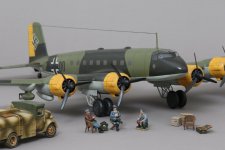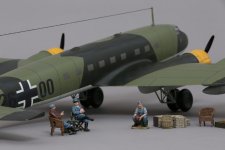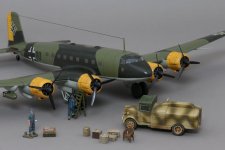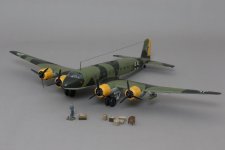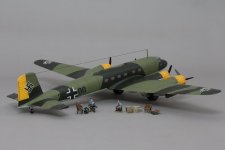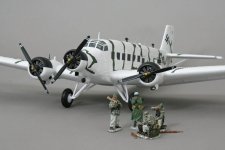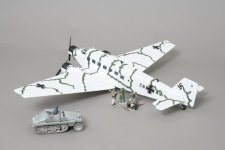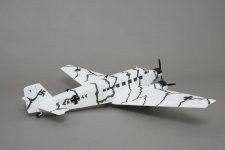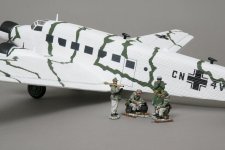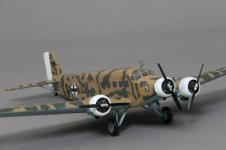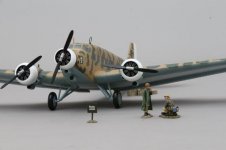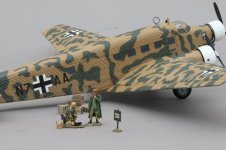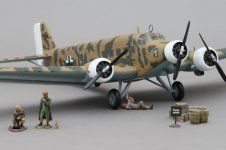Gunn Miniatures
Command Sergeant Major
- Joined
- Jun 18, 2009
- Messages
- 2,724
Dear all hope you had a good Christmas and New Year. Apologies for the delay but due to staff illness and holidays this newsletter was delayed for a brief 24 hours! To kick off the new year we have a new large model aircraft on offer for immediate dispatch with two or three more arriving in the very near future.
WOW166; The North American B-25 Mitchell was an American twin-engine, medium bomber manufactured by North American Aviation (NAA) company. The design was named in honour of Major General William (Billy) Mitchell, a pioneer of U.S. military aviation. Used by many Allied air forces, the B-25 served in every theatre of World War II and after WW2 ended many remained in service, operating across four decades.
Produced in numerous variants, nearly 10,000 Mitchells rolled from NAA factories.
The majority of B-25s in American service were used in the war against Japan in Asia and the Pacific. The Mitchell fought from the North of the Pacific to the Southc and also the Far East. These areas included the campaigns in the Aleutian Islands, Papua New Guinea, the Solomon Islands, New Britain, China, Burma and the island hoping campaign in the Central Pacific. The aircraft's potential as a ground-attack aircraft emerged during the Pacific war. The jungle environment reduced the usefulness of medium-level bombing and made low level attack the best tactic. Using similar mast height level tactics and skip bombing, the B-25 proved itself to be a suitable anti-shipping weapon and sank many enemy vessels of various types. An ever-increasing number of forward firing guns made the B-25 a formidable strafing aircraft for island warfare. The strafe versions were the B-25C1/D1, the B-25J1 and with the NAA strafer nose, the J2 sub-series.
In Burma, the B-25 was often used to attack Japanese communication links, especially bridges in Central Burma. It also helped supply the besieged troops in Imphal in 1944. The China Air Task Force, The Chinese American Composite Wing, the First Air Commando Group, the 31st Bomb Group and eventually, the relocated 12th Bomb Group, all operated the B-25 in the China Burma India theatre. Many of these missions involved battle field isolation, interdiction and close air support. Our 1/30 scale version is the strafer variant with the exotic nose art '1 for the Gipper' adorning the front flown by the 100BS which was part of 42nd BG. For those of you unaware of the story behind the nose art, please read below:
George Gipp (February 18, 1895 - December 14, 1920), nicknamed "The Gipper", was a college football player who played for the University of Notre Dame. Gipp was selected as Notre Dame's first Walter Camp All-American. Gipp played several positions, particularly halfback, quarterback and punter. Gipp died at the age of 25 of a streptococcal throat infection, days after leading Notre Dame to a win over Northwestern in his senior season, and is the subject of Knute Rockne's famous "Win just one for the Gipper" speech. In the 1940 film Knute Rockne, All American he was portrayed by Ronald Reagan who we all know went on to become President of the USA.
This model is a limited edition of 10 pieces worldwide (with 5 available now) and is priced at $1500 which includes free postage to most locations worldwide. Please note there is no free figure available with this model at present.

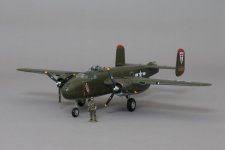
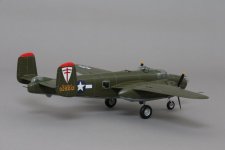
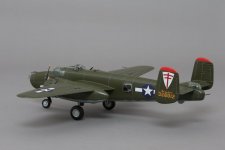
WOW166; The North American B-25 Mitchell was an American twin-engine, medium bomber manufactured by North American Aviation (NAA) company. The design was named in honour of Major General William (Billy) Mitchell, a pioneer of U.S. military aviation. Used by many Allied air forces, the B-25 served in every theatre of World War II and after WW2 ended many remained in service, operating across four decades.
Produced in numerous variants, nearly 10,000 Mitchells rolled from NAA factories.
The majority of B-25s in American service were used in the war against Japan in Asia and the Pacific. The Mitchell fought from the North of the Pacific to the Southc and also the Far East. These areas included the campaigns in the Aleutian Islands, Papua New Guinea, the Solomon Islands, New Britain, China, Burma and the island hoping campaign in the Central Pacific. The aircraft's potential as a ground-attack aircraft emerged during the Pacific war. The jungle environment reduced the usefulness of medium-level bombing and made low level attack the best tactic. Using similar mast height level tactics and skip bombing, the B-25 proved itself to be a suitable anti-shipping weapon and sank many enemy vessels of various types. An ever-increasing number of forward firing guns made the B-25 a formidable strafing aircraft for island warfare. The strafe versions were the B-25C1/D1, the B-25J1 and with the NAA strafer nose, the J2 sub-series.
In Burma, the B-25 was often used to attack Japanese communication links, especially bridges in Central Burma. It also helped supply the besieged troops in Imphal in 1944. The China Air Task Force, The Chinese American Composite Wing, the First Air Commando Group, the 31st Bomb Group and eventually, the relocated 12th Bomb Group, all operated the B-25 in the China Burma India theatre. Many of these missions involved battle field isolation, interdiction and close air support. Our 1/30 scale version is the strafer variant with the exotic nose art '1 for the Gipper' adorning the front flown by the 100BS which was part of 42nd BG. For those of you unaware of the story behind the nose art, please read below:
George Gipp (February 18, 1895 - December 14, 1920), nicknamed "The Gipper", was a college football player who played for the University of Notre Dame. Gipp was selected as Notre Dame's first Walter Camp All-American. Gipp played several positions, particularly halfback, quarterback and punter. Gipp died at the age of 25 of a streptococcal throat infection, days after leading Notre Dame to a win over Northwestern in his senior season, and is the subject of Knute Rockne's famous "Win just one for the Gipper" speech. In the 1940 film Knute Rockne, All American he was portrayed by Ronald Reagan who we all know went on to become President of the USA.
This model is a limited edition of 10 pieces worldwide (with 5 available now) and is priced at $1500 which includes free postage to most locations worldwide. Please note there is no free figure available with this model at present.






